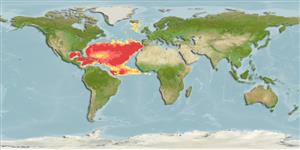Actinopterygii (ray-finned fishes) >
Ophidiiformes (Cusk eels) >
Ophidiidae (Cusk-eels) > Brotulotaeniinae
Etymology: Brotulotaenia: Latin, brotula, -ae = little, bud, shoot + Latin, taenia = stripe (Ref. 45335).
Environment / Climate / Range
Ecology
Marine; bathypelagic; depth range 1000 - 1100 m (Ref. 57178). Deep-water, preferred ?
Atlantic Ocean: discontinuous distribution.
Size / Weight / Age
Maturity: Lm ? range ? - ? cm
Max length : 30.0 cm SL male/unsexed; (Ref. 6555)
Short description
Morphology | Morphometrics
Dorsal
soft rays
(total): 113-115;
Anal
soft rays: 91 - 94. Scales small, non-imbricate prickles; opercle with no spine; median basibranchial tooth patch absent; gill rakers are tooth-bearing tubercles; otolith very small and rounded; precaudal vertebrae 12-15 (Ref. 34024).
Mesopelagic (Ref. 75154) and uncommon species (Ref. 34024). Oviparous (Ref. 6555). Oval, pelagic eggs float in a gelatinous mass (Ref. 205).
Life cycle and mating behavior
Maturity | Reproduction | Spawning | Eggs | Fecundity | Larvae
Nielsen, J.G., D.M. Cohen, D.F. Markle and C.R. Robins, 1999. Ophidiiform fishes of the world (Order Ophidiiformes). An annotated and illustrated catalogue of pearlfishes, cusk-eels, brotulas and other ophidiiform fishes known to date. FAO Fish. Synop. 125(18):178p. Rome: FAO. (Ref. 34024)
IUCN Red List Status (Ref. 115185)
CITES (Ref. 94142)
Not Evaluated
Threat to humans
Harmless
Human uses
Fisheries: of no interest
More information
Age/SizeGrowthLength-weightLength-lengthLength-frequenciesMorphometricsMorphologyLarvaeLarval dynamicsRecruitmentAbundance
ReferencesAquacultureAquaculture profileStrainsGeneticsAllele frequenciesHeritabilityDiseasesProcessingMass conversion
Tools
Special reports
Download XML
Internet sources
Estimates of some properties based on models
Phylogenetic diversity index (Ref.
82805): PD
50 = 0.5625 [Uniqueness, from 0.5 = low to 2.0 = high].
Bayesian length-weight: a=0.00102 (0.00046 - 0.00225), b=3.06 (2.88 - 3.24), in cm Total Length, based on all LWR estimates for this body shape (Ref.
93245).
Trophic Level (Ref.
69278): 3.6 ±0.6 se; Based on size and trophs of closest relatives
Resilience (Ref.
69278): Medium, minimum population doubling time 1.4 - 4.4 years (Preliminary K or Fecundity.).
Vulnerability (Ref.
59153): Moderate vulnerability (36 of 100) .
